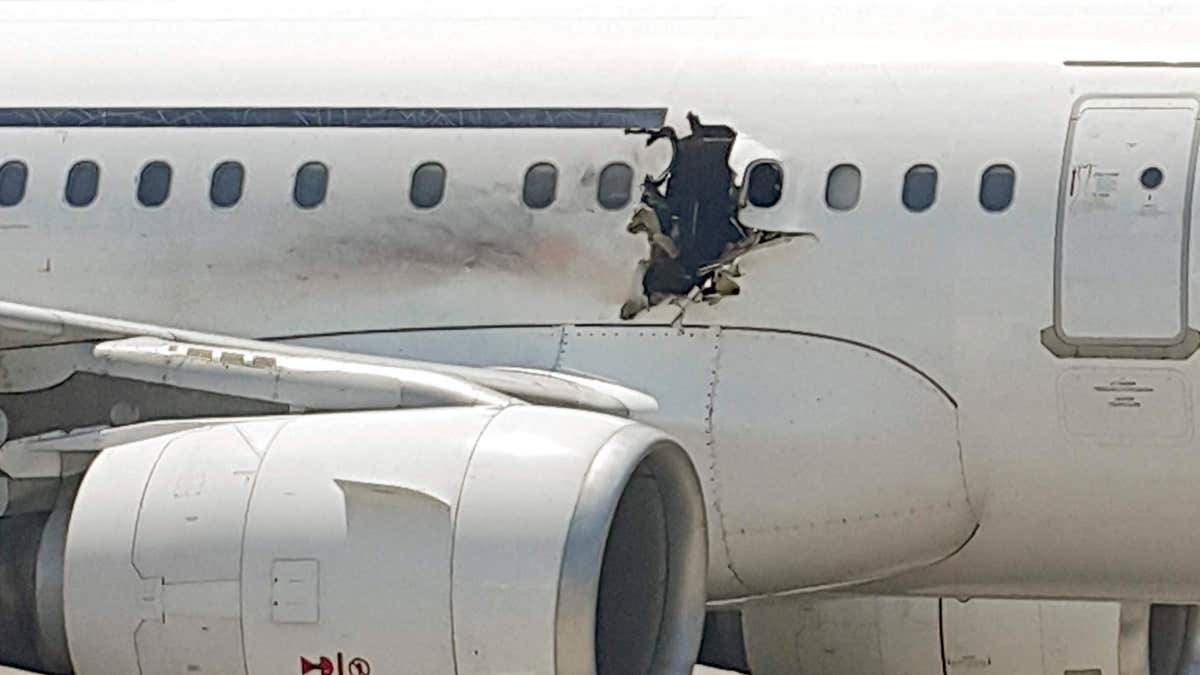
FILE - In this Tuesday, Feb. 2, 2016 file photo, a hole is photographed in a plane operated by Daallo Airlines as it sits on the runway of the airport in Mogadishu, Somalia. (AP)
Somalia’s Islamic extremist terror group, Al Shabaab, said Saturday they carried out the bombing of a commercial passenger jet earlier this month that blew a hole in the fuselage, sucking out the suspected bomber and forcing the plane to make an emergency landing.
Western and Turkish intelligence agents aboard the Daallo Airlines flight to Djibouti on Feb. 2 were the targets of the bombing, the terror group said in a statement. The Al Qaeda-affiliated group said it had planned to destroy the Airbus 321 plane but failed.
Experts told Fox News earlier this month that Al Shabaab was the main suspect in the terror incident.
The bomb detonated shortly after takeoff from Mogadishu airport, when the plane was at 11,000 feet and ascending. Experts said if the plane had been at its intended cruising altitude of 30,000 feet, the explosion could’ve brought the plane down.
Authorities in the Balcad region, about 19 miles north of Mogadishu, later said they found the body of a man believed to have been sucked out of the plane, Reuters reported.
"The dead body of the passenger is being transported to Mogadishu," a police officer at the Mogadishu airport said. "He dropped when the explosion occurred in the plane.”
Security at the Mogadishu airport is normally extremely tight as the terror group controls territory within sight of the airport and under the flight path for departing aircraft, sources in the area told Fox News.
However, security video footage taken at Mogadishu airport shows two men handing what looks like a laptop computer to the suspected suicide bomber after he passed through the security checkpoint.
Somali authorities said at least one of the men delivering the laptop was an airport employee. Authorities believe the laptop-like device was the bomb that caused the explosion.
At least 20 people including the airport employee have been arrested in connection to the attack.
Abdullahi Abdisalam Borleh, the suspected suicide bomber, was a passenger and was blown out of the plane.
Al Shabaab -- whose name means “The Youth” in Arabic -- was forged in the years of anarchy that engulfed Somalia after warlords ousted dictator Siad Barre in 1991. Inspired by a Saudi-style Wahabi, or ultra-orthadox version of Islam, Al Shabaab now numbers an estimated 7,000-9,000 fighters.
It controlled Mogadishu, and briefly aligned Al Qaeda in 2012 in a bid to impose Shariah law on Somalia's urban centers, but infighting over tactics doomed the deadly union.
Now based in Kenya and Somalia's rural areas, Al Shabaab is on the run, but still deadly. In June 2014, Al Shabaab fighters stormed the Kenyan village of Mpeketoni, about 60 miles from the Somali border and murdered 48 people for not being Muslim. The following month, they attacked the palace of President Hassan Sheikh Mohamud in Mogadishu, and entered the heavily fortified compound before government forces killed the militants.
The deadly terror sect also was responsible in September 2013 for the infamous attack at the Westgate Shopping Center in the Kenyan capital of Nairobi, where 67 people were killed and more than 175 wounded.
The group has publicly vowed to carry out terror attacks in Kenya in response to that country’s military actions in Somalia, and appears to be making another move into the Somali capital.
The Associated Press contributed to this report.
